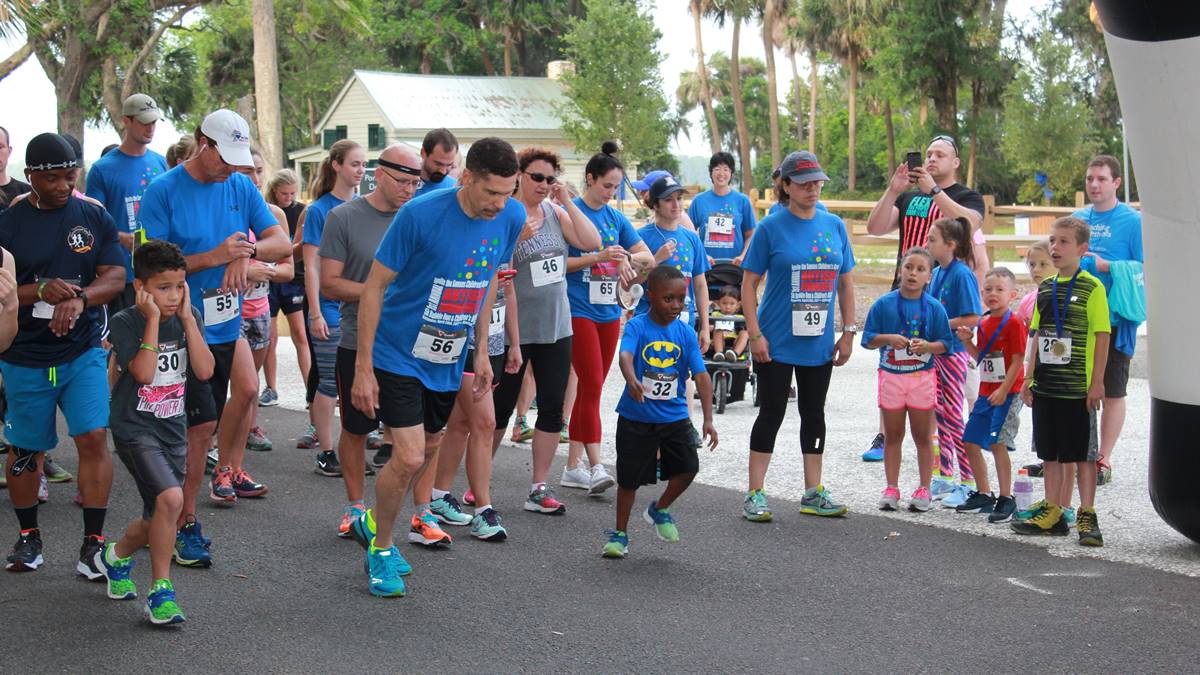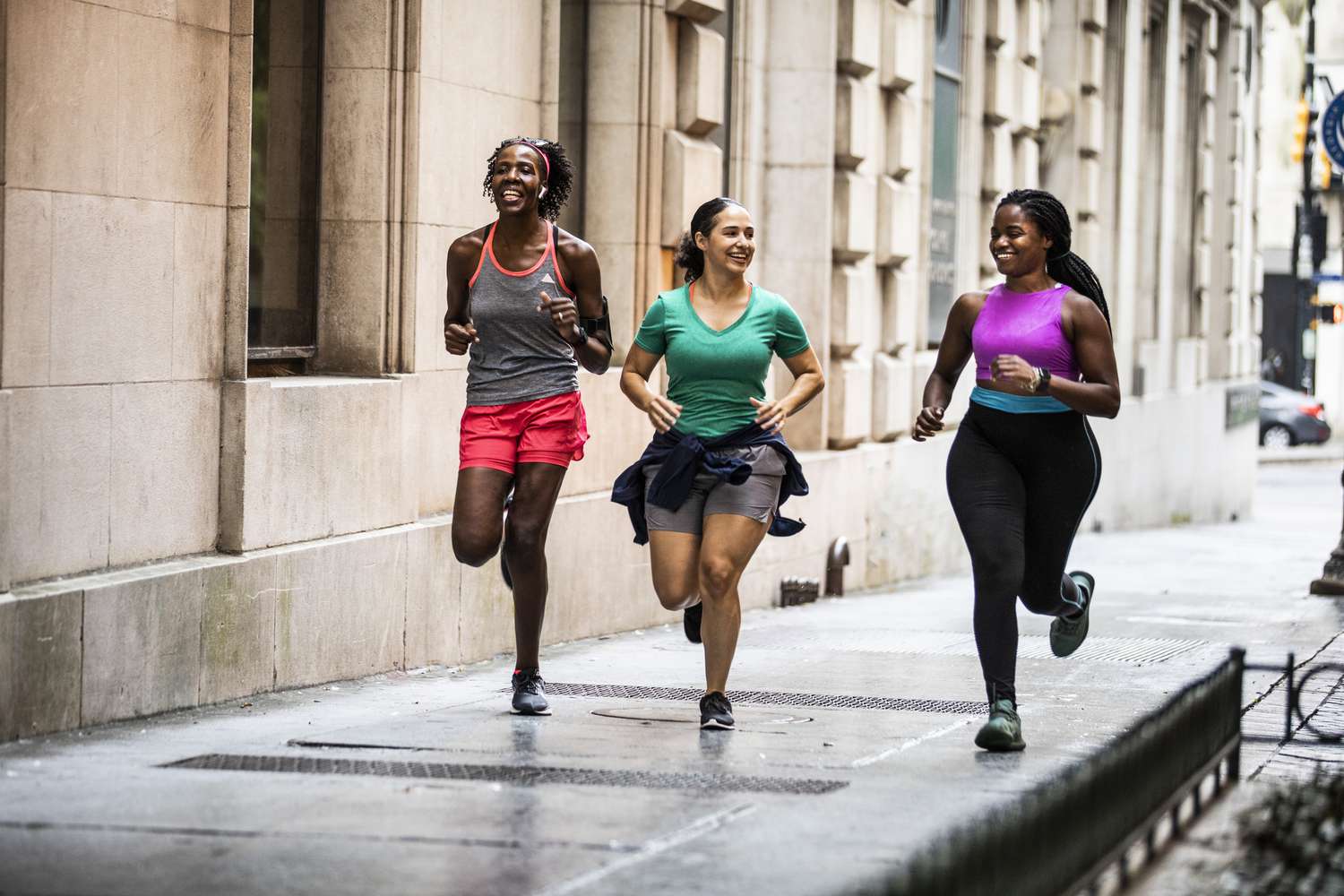

Featured
How Long Is The First Couch To 5K Run
Modified: March 1, 2024
Discover the perfect couch to 5K training plan for beginners featured in this informative article. Find out how long the first run should be and get ready to hit the road!
Introduction
Welcome to the world of running! Whether you are a complete beginner or someone who wants to get back into shape, the Couch to 5K program is an excellent starting point. Designed for individuals who have little to no running experience, this program gradually builds endurance and prepares you to complete a 5K (3.1 miles) run.
Embarking on your first Couch to 5K run can be both exciting and overwhelming. It is an important milestone that sets the tone for your entire running journey. The first run serves as a foundation upon which you can build your stamina, speed, and overall fitness level.
In this article, we will delve deeper into the significance of your first Couch to 5K run and provide you with valuable insights to help you navigate through it. We will explore the factors that influence the duration of your initial run, tips to prepare for it, and the typical length of this important milestone. Additionally, we will share practical advice on how to overcome challenges and stay motivated throughout your first run.
Whether your goal is to improve your cardiovascular health, lose weight, or simply challenge yourself, the Couch to 5K program is an effective way to achieve these objectives. With determination, perseverance, and following a well-structured training plan, you can transform yourself from a beginner runner to successfully completing a 5K race.
Overview of the Couch to 5K Program
The Couch to 5K program, also known as C25K, is a popular training plan designed to guide beginners through a gradual progression of running. It provides structure and support to help individuals go from a sedentary lifestyle to completing a 5K run in just a few weeks.
The program typically lasts for nine weeks and consists of three workouts per week. Each session combines walking and running intervals, gradually increasing the amount of time spent running and reducing the time spent walking. This gradual progression allows your body to adapt and build endurance over time.
One of the key principles of the Couch to 5K program is the concept of interval training. By alternating between periods of moderate-intensity running and walking, you can slowly acclimate your body to the demands of running without overexertion or risk of injury.
The program is flexible and can be tailored to your fitness level. If you find a particular week or workout challenging, you can repeat it until you feel comfortable before moving on to the next session. It is important to listen to your body and not push yourself too hard, especially during the initial stages of the program.
Many individuals have found the Couch to 5K program to be a transformative experience. It provides a structured approach that gradually builds confidence, endurance, and overall fitness. As you progress through the program, you will start to notice improvements in your cardiovascular capacity, muscular strength, and mental resilience.
The Couch to 5K program is also a great way to connect with a community of like-minded individuals. There are various online forums, social media groups, and local running clubs dedicated to supporting and encouraging participants in their journey. Sharing your progress, milestones, and challenges with others can be both motivating and rewarding.
Remember, the Couch to 5K program is about more than just running a certain distance. It is about adopting a healthier lifestyle, embracing the joy of movement, and achieving personal goals. So lace up your running shoes, get ready to challenge yourself, and let the Couch to 5K program be your guide on this exhilarating journey!
Importance of the First Run
The first run of the Couch to 5K program holds great significance in your fitness journey. It sets the tone for your training and prepares you mentally and physically for the weeks ahead.
One of the primary reasons the first run is important is that it serves as a benchmark for your current fitness level. It allows you to assess your starting point and helps you track your progress over time. By establishing a baseline, you can see how far you have come by the end of the program.
The first run also helps to build confidence. Starting a new fitness endeavor can be intimidating, especially if you are not accustomed to running. Completing that initial run, no matter the duration or difficulty, instills a sense of achievement and gives you the belief that you can continue and succeed.
Additionally, the first run is an opportunity to familiarize yourself with the mechanics of running. You can experiment with your running form, find a comfortable pace, and understand how your body responds to different levels of exertion. This self-awareness becomes invaluable as you progress through the program and begin to push your limits.
Another important aspect of the first run is to gauge your cardiovascular endurance. This run serves as a reminder that even a small amount of physical activity requires effort. Running, like any aerobic exercise, challenges your heart and lungs, and the initial run helps you become aware of your current cardiovascular fitness.
The first run also provides a chance to identify areas of improvement and potential challenges that may arise during your training. You may notice muscular imbalances, an uneven gait, or areas of discomfort. Addressing these issues early on can help prevent future injuries and ensure a smoother progression in your running journey.
Lastly, the first run is an opportunity to develop mental resilience and learn to overcome obstacles. It is normal to feel doubts or discomfort during the initial stages of the program. Pushing through these challenges and completing that first run builds mental toughness and determination that will carry you forward throughout the rest of the program.
Overall, the first run of the Couch to 5K program plays a crucial role in your fitness journey. It serves as a starting point, a confidence booster, and a stepping stone toward achieving your running goals. Embrace the experience, stay committed, and remember that every step counts!
Factors Influencing the Duration of the First Run
The duration of the first run in the Couch to 5K program can vary from person to person. Several factors contribute to the length of this initial run and understanding these factors can help you better prepare and manage your expectations.
1. Current fitness level: Your current fitness level plays a significant role in determining the duration of your first run. If you have been leading a sedentary lifestyle, it is natural to start with shorter running intervals and longer periods of walking. On the other hand, if you are already active or have experience with other forms of cardio exercise, you may be able to handle longer running intervals from the beginning.
2. Age and body condition: Age and overall body condition can impact your running endurance. Younger individuals tend to have greater stamina and faster recovery times, while older individuals or those with certain health conditions may need to take a more cautious approach. It is important to listen to your body and adapt the program to your specific needs.
3. Previous running experience: If you have some prior running experience, even if it was a while ago, your body may already have some muscle memory and cardiovascular conditioning. This could allow you to progress faster through the program and potentially have a longer duration for your first run.
4. Mental mindset: Your mental attitude and determination can significantly affect the duration of your first run. If you approach the run with a positive mindset, willing to challenge yourself and embrace the discomfort, you may be able to push through longer intervals. Conversely, if you approach it with fear or doubt, you may find it more challenging to sustain a longer run.
5. Environmental factors: The conditions in which you run can also impact the duration of your first run. Factors such as temperature, humidity, elevation, and terrain can affect your performance and comfort level. It is important to take these factors into consideration and make adjustments accordingly.
6. Nutrition and hydration: Proper nutrition and hydration play a crucial role in your performance and endurance during the first run. Fueling your body with a balanced meal or snack before the run and staying hydrated throughout can help you sustain longer running intervals.
Remember, the goal of the Couch to 5K program is gradual progression. It is completely normal to start with shorter running intervals and gradually increase the duration as your body adapts to the demands of running. Focus on your own journey and celebrate the small victories along the way.
Preparing for the First Run
Preparing for your first run in the Couch to 5K program is essential to ensure a smooth and successful experience. Taking the time to properly prepare yourself physically, mentally, and logistically will greatly enhance your chances of completing the run comfortably. Here are some key tips to help you get ready:
1. Invest in proper running shoes: Having the right pair of running shoes is crucial for injury prevention and comfort. Visit a specialty running store to get fitted for shoes that suit your foot type and running style.
2. Warm-up and stretch: Prior to your first run, perform a warm-up routine to loosen up your muscles and increase blood flow. Follow it up with dynamic stretches to prepare your body for the physical demands of running.
3. Follow the Couch to 5K program: Familiarize yourself with the structure and schedule of the Couch to 5K program. Understand the intervals and aim to abide by them during your first run.
4. Choose the right time and location: Select a time of day that works best for you and find a safe and comfortable location to run. Consider factors such as weather, traffic, and the availability of well-lit areas.
5. Hydrate and fuel up: Drink water to hydrate your body before the run, especially if it’s a longer duration. Consume a light, balanced meal or snack that provides sufficient energy to fuel your run without causing discomfort.
6. Set realistic expectations: Understand that your first run may not be a long-distance sprint. Be realistic in your expectations and don’t be too hard on yourself. It’s about building endurance gradually, so start with shorter intervals and gradually increase as you progress through the program.
7. Listen to your body: Pay attention to any discomfort or pain during the run. If something feels off or if you experience prolonged pain, it’s important to adjust your pace or stop if necessary. Push yourself, but not at the expense of your well-being.
8. Stay motivated: Keep your motivation high by setting goals and celebrating small victories along the way. Find a running buddy or join a supportive online community to share your progress and cheer each other on.
9. Mind your form: Focus on maintaining proper running form during your first run. Keep your posture upright, relax your shoulders, and land softly on the midfoot. This will help prevent injuries and optimize your running efficiency.
Remember, the first run is just the beginning of your Couch to 5K journey. Approach it with enthusiasm, take the necessary precautions, and most importantly, enjoy the experience. Be proud of yourself for taking the first step towards a healthier and more active lifestyle.
Typical Duration of the First Couch to 5K Run
The duration of the first Couch to 5K run can vary depending on several factors, including individual fitness levels, previous running experience, and overall health conditions. It is important to remember that everyone progresses at their own pace, and there is no “one-size-fits-all” answer. However, there are some general guidelines to give you an idea of what to expect.
For most beginner runners starting the Couch to 5K program, the first run usually consists of a combination of walking and running intervals. The program typically begins with short intervals of running and longer intervals of walking to ease participants into the process gradually.
On average, the initial run may involve running for around 1-2 minutes followed by a walking interval of approximately 1-2 minutes. This pattern is repeated for a total duration of around 20-30 minutes, including warm-up and cool-down periods. The specific duration can vary depending on individual factors and the specific program or training plan you are following.
It is important to note that the primary objective of the first run is to establish a baseline and introduce your body to the demands of running. The emphasis is not on distance or speed but rather on building endurance and getting your body accustomed to the new activity.
If you are a complete beginner, do not be discouraged if the first run feels challenging or shorter than expected. Remember that the Couch to 5K program is designed to progress gradually over several weeks, allowing your body to adapt and improve over time. Each run will gradually increase in duration and intensity as the weeks go by.
It is crucial to listen to your body and not push yourself beyond your limits during the first run. Your focus should be on completing the intervals as directed and maintaining good form. As you progress through the program, you will gradually increase your running intervals and decrease the walking intervals, ultimately building up to a continuous 5K run by the end of the program.
Keep in mind that the duration of your first run should not be a cause for comparison or competition with others. Your journey is unique to you, and the most important thing is to listen to your body, be patient, and celebrate every milestone along the way.
Remember, the Couch to 5K program is a progressive training plan, and the initial run is just the starting point of your exciting running journey. Trust the process, stay consistent, and have faith in your ability to achieve your goal of running a 5K!
Tips to Increase Running Duration Gradually
As you progress through the Couch to 5K program, your running duration will gradually increase. This progressive approach allows your body to adapt and build endurance over time. Here are some helpful tips to help you increase your running duration gradually:
1. Follow the program: Stick to the prescribed intervals and gradually increase the duration of your running segments as instructed by the Couch to 5K program. Consistency is key to gradual progress.
2. Listen to your body: Pay attention to any signs of fatigue or discomfort during your runs. It is important to find a balance between pushing yourself to challenge your limits and avoiding overexertion or injury. Adjust your pace or take extra rest days if needed.
3. Take small increments: Increase your running duration by small increments each week. This could mean adding 30 seconds to a minute of running to your intervals. Gradual increases help prevent excessive strain on your body and reduce the risk of injury.
4. Include rest days: Allow for adequate rest and recovery between running days. Building endurance involves stress and adaptation, and rest days provide your body with the time it needs to recover and strengthen.
5. Focus on form: Pay attention to your running technique and form. Good form helps you become more efficient and reduces the risk of injuries. Keep your posture upright, shoulders relaxed, and land softly on your midfoot.
6. Cross-training: Incorporate cross-training activities, such as cycling, swimming, or strength training, into your routine. These activities help improve overall fitness and support your running progress while giving your running muscles a break.
7. Gradually decrease walking intervals: As you build endurance, gradually reduce the duration of your walking intervals and increase the time spent running. Aim to find a comfortable balance between running and walking to allow yourself to recover while continuing to challenge your fitness.
8. Set realistic goals: Set realistic goals for increasing your running duration. Focus on gradual improvement rather than rushing to achieve a specific time or distance. Celebrate small victories along the way to stay motivated.
9. Stay consistent: Consistency is vital for progress. Make running a regular part of your routine and try to maintain a consistent schedule. Consistent training will help your body adapt and overcome plateaus.
10. Listen to music or podcasts: To help distract your mind and make longer running intervals more enjoyable, listen to your favorite music or podcasts while running. It can provide a mental boost and make the time fly by.
Remember, progression takes time and patience. Enjoy the journey and trust the process. With gradual increases in running duration and consistency, you will soon find yourself completing longer runs and achieving your Couch to 5K goal of running a 5K race!
Common Challenges Faced During the First Run
The first run of the Couch to 5K program, like any new endeavor, can come with its share of challenges. It’s important to be aware of these challenges and know how to overcome them, ensuring a successful and enjoyable experience. Here are some common challenges you may encounter during your first run:
1. Physical discomfort: It’s natural to experience physical discomfort during your first run, especially if you’re not accustomed to running. You may feel muscle soreness, fatigue, or shortness of breath. Take it slow, listen to your body, and give yourself time to adjust.
2. Mental barriers: Your mind can often be your biggest obstacle. Negative thoughts, self-doubt, or a lack of confidence may creep in during the first run. Remind yourself that it’s normal to feel this way and focus on positive self-talk to push through the mental barriers.
3. Starting too fast: It’s easy to get caught up in the excitement of your first run and start at a faster pace than you can sustain. Starting too fast can quickly lead to burnout or fatigue. Pace yourself and remember that the goal is gradual progression over time.
4. Breathing difficulties: Proper breathing technique is crucial for running efficiently. Uncontrolled or shallow breathing can lead to fatigue and cramping. Focus on deep diaphragmatic breathing, inhaling through your nose and exhaling through your mouth, to optimize oxygen intake.
5. Lack of stamina: If you have a sedentary lifestyle or are new to physical activity, you may find it challenging to maintain stamina during the first run. Remember that building endurance takes time, and the program is designed to gradually increase your fitness levels.
6. Muscle soreness: It’s common to experience muscle soreness or stiffness, especially in your legs, during and after the first run. This is a normal response to the new activity. Make sure to include a proper warm-up and cooldown, as well as stretching exercises, to help alleviate muscle soreness.
7. Inconsistent rhythm: Finding a comfortable running rhythm can be difficult during the first run. It may take some time to find your ideal cadence and stride. Experiment with different techniques and focus on finding a rhythm that feels natural and sustainable for you.
8. Weather conditions: Weather can have a significant impact on your first run experience. Extreme temperatures, high humidity, or unfavorable weather conditions can make the run more challenging. Dress appropriately, stay hydrated, and consider choosing a suitable time of day to avoid the harshest weather conditions.
9. Overcoming the “quit” mentality: When faced with difficulties or discomfort, it’s easy to give in to the temptation of quitting. Remind yourself of your goals, stay focused, and embrace the discomfort as an opportunity for growth. Push through the challenging moments, and remember that completing the run will bring a sense of accomplishment and pride.
10. Comparison to others: Avoid comparing yourself to others during your first run. Each individual has their unique journey, fitness level, and starting point. Remember that the Couch to 5K program is designed to build you up gradually and that progress is personal and subjective.
By anticipating and acknowledging these common challenges, you can mentally prepare yourself to tackle them head-on. Remember to approach your first run with patience, persistence, and a positive mindset. Embrace the challenges as opportunities for growth and celebrate every small victory along the way.
How to Stay Motivated During the First Run
Maintaining motivation during the first run of the Couch to 5K program is essential to ensuring a successful and enjoyable experience. Here are some effective strategies to help you stay motivated and committed throughout your initial run:
1. Set clear goals: Start by setting clear and specific goals for your first run. Whether it’s completing a certain distance, achieving a specific running interval, or simply enjoying the process, having a clear objective gives you something to strive for and helps maintain your motivation.
2. Remind yourself of your why: Reflect on the reasons why you decided to embark on the Couch to 5K program. Whether it’s improving your health, challenging yourself, or achieving a personal milestone, reconnecting with your reasons can reignite your motivation and remind you of the purpose behind your efforts.
3. Create a motivating playlist: Curate a playlist of energizing and uplifting music that inspires you. Music has a powerful impact on our mood and can boost motivation during your run. Choose songs that resonate with you and help you push through any challenging moments.
4. Find a running buddy or community: Joining a running group or finding a running buddy can provide accountability and a sense of camaraderie. Having someone to share your running journey with can make the experience more enjoyable and keep you motivated to show up for your runs.
5. Celebrate small milestones: Acknowledge and celebrate your achievements along the way, no matter how small they may seem. Completing each running interval, increasing your running duration, or even just showing up for your run are all accomplishments worthy of celebration. Recognizing these milestones will boost your confidence and spur you forward.
6. Visualize success: Visualize yourself successfully completing the first run and imagine how you will feel when you cross the finish line. Visualization techniques help reinforce positive beliefs and can increase your motivation to push through any challenging moments.
7. Reward yourself: Establish a reward system for yourself, linking small rewards to your running milestones. It could be treating yourself to a massage, buying a new piece of running gear, or enjoying a relaxing evening after a successful run. Rewarding yourself for your efforts can provide an extra incentive to stay motivated.
8. Track your progress: Keep a record of your runs and track your progress. Seeing how far you have come from your first run can be highly motivating. Use a running app or keep a journal to document your achievements, improvements, and any setbacks you overcome along the way.
9. Practice positive self-talk: Replace negative thoughts or doubts with positive affirmations and encouraging self-talk. Remind yourself of your capabilities, inner strength, and the progress you have made. Fuel your mind with positive thoughts to keep your motivation high.
10. Embrace the process: Finally, remember to embrace and enjoy the process. Recognize that running is a journey, and every step counts. Stay present in the moment, focus on the sensations in your body, and find joy in the act of running itself. By embracing the process, you’ll find that motivation becomes a natural byproduct of your commitment.
By implementing these strategies, you can boost your motivation and ensure a positive experience during your first run. Remember that motivation may ebb and flow, but by staying committed to your goals, finding ways to keep yourself inspired, and celebrating your progress, you can maintain your motivation throughout the Couch to 5K program.
Conclusion
Congratulations on taking the first step towards becoming a runner with the Couch to 5K program! The first run is a pivotal moment that marks the beginning of your running journey and sets the foundation for your progress. It’s important to remember that every individual’s experience is unique and that progress is made by gradually increasing running durations, listening to your body, and staying consistent.
Throughout this article, we have explored the significance of the first run, the overview of the Couch to 5K program, factors influencing the duration of the initial run, tips for preparation, expected durations, challenges you may face, and strategies to stay motivated. By understanding the importance of the first run and being aware of the challenges, you can better prepare yourself mentally and physically for the journey ahead.
Remember, the Couch to 5K program is designed to guide beginners like you. It is about building stamina and endurance gradually, pushing your limits, and achieving your goal of completing a 5K run. Celebrate every milestone along the way, no matter how small, and stay motivated by setting clear goals, finding support, and focusing on the joy of running.
As you progress through the program, it’s normal to face obstacles and experience ups and downs. However, stay resilient, believe in yourself, and embrace the process of self-improvement. Your first run is just the beginning of an incredible journey that will not only transform your physical fitness but also empower you mentally and give you a sense of accomplishment.
Keep in mind that running is not just about crossing the finish line—it’s about the joy of movement, the strength you gain, and the community you become a part of. So lace up your running shoes, embrace the challenges, and remember that every step you take brings you closer to achieving your Couch to 5K goals.
Now, go out there and conquer your first run with confidence! You have the power to achieve greatness, one step at a time. Happy running!









